国际贸易实务装运条款英文课件
- 格式:ppt
- 大小:361.00 KB
- 文档页数:7
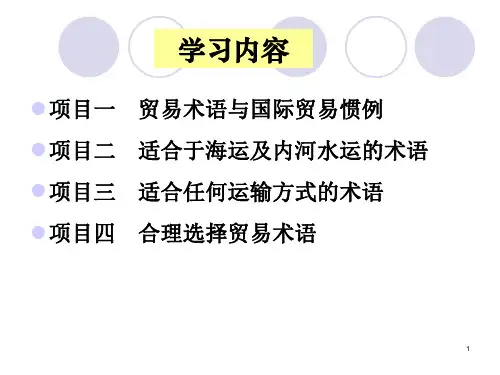
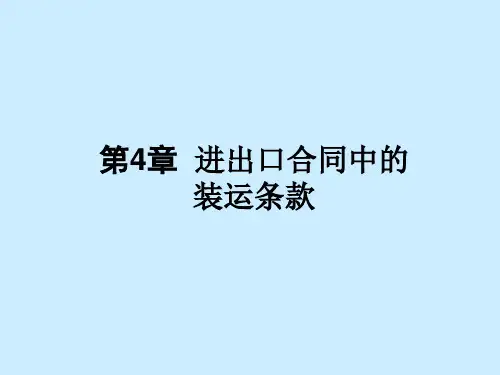
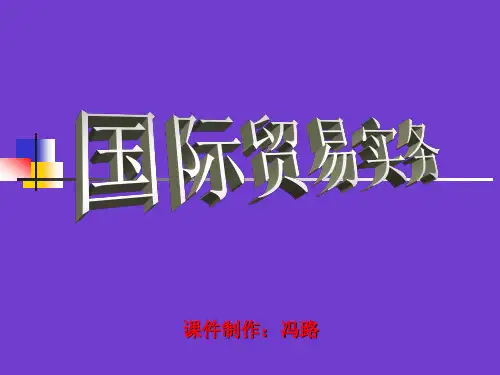
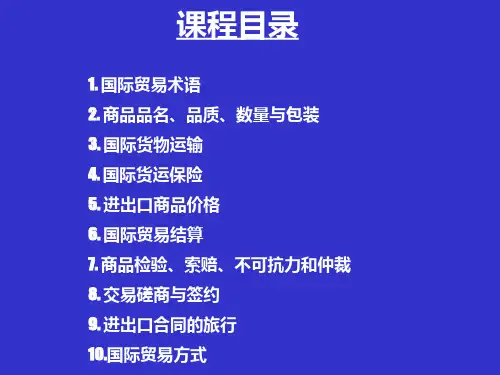

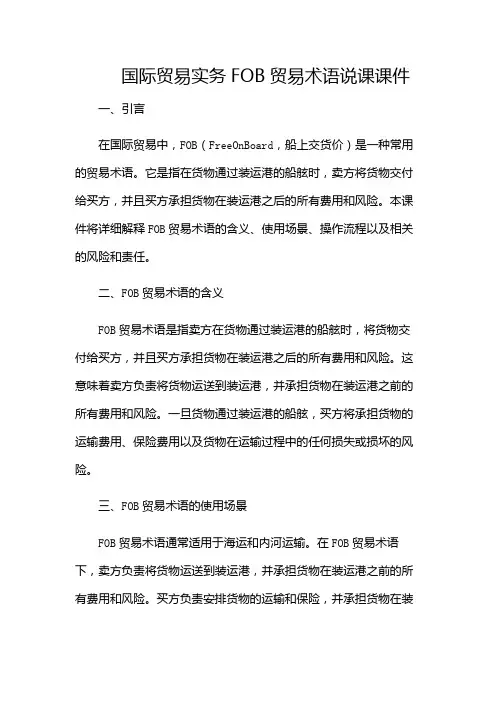
国际贸易实务FOB贸易术语说课课件一、引言在国际贸易中,FOB(FreeOnBoard,船上交货价)是一种常用的贸易术语。
它是指在货物通过装运港的船舷时,卖方将货物交付给买方,并且买方承担货物在装运港之后的所有费用和风险。
本课件将详细解释FOB贸易术语的含义、使用场景、操作流程以及相关的风险和责任。
二、FOB贸易术语的含义FOB贸易术语是指卖方在货物通过装运港的船舷时,将货物交付给买方,并且买方承担货物在装运港之后的所有费用和风险。
这意味着卖方负责将货物运送到装运港,并承担货物在装运港之前的所有费用和风险。
一旦货物通过装运港的船舷,买方将承担货物的运输费用、保险费用以及货物在运输过程中的任何损失或损坏的风险。
三、FOB贸易术语的使用场景FOB贸易术语通常适用于海运和内河运输。
在FOB贸易术语下,卖方负责将货物运送到装运港,并承担货物在装运港之前的所有费用和风险。
买方负责安排货物的运输和保险,并承担货物在装运港之后的所有费用和风险。
FOB贸易术语的使用场景包括国际贸易中的买卖合同、进出口业务以及跨国公司的供应链管理。
四、FOB贸易术语的操作流程1.签订合同:买卖双方签订合同,明确贸易术语为FOB,并约定装运港、目的港、交货期限等条款。
2.安排运输:卖方负责将货物运送到装运港,并承担货物在装运港之前的所有费用和风险。
买方负责安排货物的运输和保险,并承担货物在装运港之后的所有费用和风险。
3.发货通知:卖方在货物装船后,应及时向买方发出发货通知,包括货物名称、数量、装运日期、装运港、目的港等信息。
4.付款和交单:买方在收到发货通知后,按照合同约定的付款方式向卖方支付货款。
卖方向买方提供提单等交单文件。
5.货物交付:卖方在货物通过装运港的船舷时,将货物交付给买方。
买方承担货物在装运港之后的所有费用和风险。
五、FOB贸易术语的风险和责任在使用FOB贸易术语时,买卖双方需要明确各自的风险和责任。
卖方需要承担货物在装运港之前的所有费用和风险,包括货物损失、损坏、延误等。

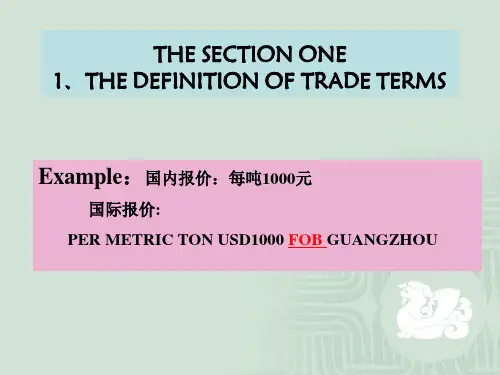
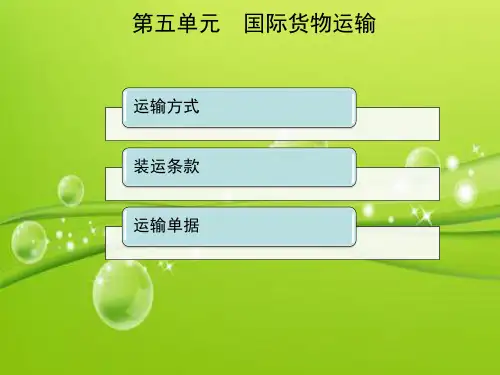
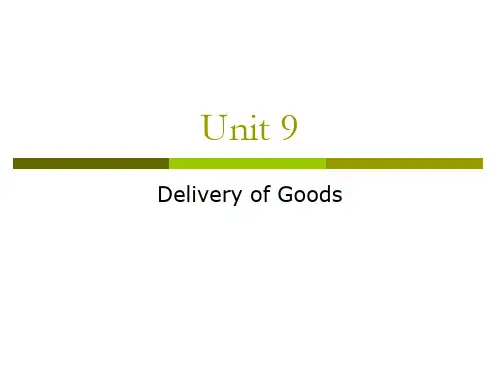
Unit 9 Delivery of GoodsThe delivery of the goods means that the seller delivers the contract goods at the agreed time, place and in the agreed manners to the buyer. In international sales of goods, the delivery also means to transfer the necessary documents at the stipulated time to the buyer.(一)Modes of TransportSea Land AirCharterLinerRailway, train Roadway, truck AirlineUps, Fedex, DHL,EMSPostal Parcel TransportCombined Transport OCP Transport: Overland common pointLand Bridge Transport Multi-modal CombinedTransportation1、Charter租船Voyage Charter 1)ModesTime Charter2) Stipulation of Loading &Unloading ChargesF.O. F.I. F.I.O.Liner Terms (Gross Terms)3)Lay-time and Dispatch, Demurrage2. Liner 班轮运输☐The main features of liners usually include:☐a. The liner has a regular line, port, timetable and comparatively fixed freight,which is thebasic features of liners. But the quantity of transport is not fixed. 四定一不定☐b. The ship-owner usually leases part of shipping space instead of the whole ship.☐c. The carrier is responsible for loading and unloading operations, i.e., Gross Terms.☐d. The B/L drawn by the shipping company is the shipping contract between the carrier and the consignor. The rights and obligations of the carrier and the consignor are based on the B/L drawn by the shipping company.Freight of Liner☐Freight is the remuneration payable to the carrier for the carriage of goods. The freight paid for the carriage by a liner differs in the way of calculating from that paid under a charter party. Freight = Fb + ∑S☐In which:☐Fb----Basic freight☐S----SurchargesRailway Transport☐Railway is capable of attaining relatively high speeds with large quantities and is , safe, at low cost, punctual, rather economical and less influence by weather. ☐Railway transport falls into 4 kinds:☐a. Railway transport at home;☐b. Railway transport to H.K. and Macao;☐c. International railway transport between two countries;Air Transport航空运输The advantages of air transport are high speed and quick transit, low risk of damage and pilferage with very competitive insurance, saving in packing cost, reducing amount of capital tied up in transit and so on.While the chief disadvantage is the limited capacity of air freighter and overall dimensions of acceptable cargo together with weight restrictions. Also bad weather may restrict flights, costly airports are required and goods may have to taken a considerable distances by road or rail before and after the flight.However, it is suitable those goods that are of time pressing, small quantity of cargoes but urgent need, light but precious.International Combined Transport☐Definition: International combined transport means the conveyance of cargo includes at least two modes oftransport by which the goods are carried from the place of dispatch to that of destination on the basis of combinedtransport or a multimodal transport contract. Under thismethod, the container is used an intermedium and make up of an international multimodal and join transport mode by sea, air and land.☐It usually includes:☐ a.Train-Air (or Truck-Air, or Ship-Air)☐The export goods are carried to Hong Kong by train or truck or ship and then loaded into airplanes at Hong Kong.☐ b.Train-Ship☐The export goods from Chinese interior provinces may also be transported to Hong Kong by railway for transshipment to foreign ports by vessels.☐ c. Container Transport/Containerized TrafficContainer transport falls into 2 kinds (methods of consignment):☐ a. full container load (FCL);☐ b. less than container load (LCL).☐As for the consignment that reaches the demand of FCL, the vanning FCL is done either by the consignor himself or the carrier at the production side or the warehouse, then it is sent to the container yard(CY) for consilidation by thecarrier.☐As for the consignment that does not reach the demand ofa full container, we call it less than container, the vanningLCL is done by the consignor himself and then send theconsignment to the container freight station(CFS) or inland container depot for consolidation by the carrier, who willpiece together the goods according to the nature,destinationa, weight and so on in the container and then send it to the CY.Land bridge transport☐Land bridge transport is a mode of transport that connects the ocean transport on the two sides of the land by the railway and land which runs across the continent, i.e., ship-train-ship. Land bridge transport uses the container as a medium, so it has all advantages of container transport.☐There are 3 main land bridges in the world:☐a. American land bridge;☐b. Siberian land bridge.☐c.The New European-Asia land bridge.International multimodal Combined transport☐The basic conditions of international multimodal transport are:☐(1) Transport documents, i.e., combined transport documents (MTD) shall cover the whole journey;☐(2) It includes 2 or more different modes of successive transportation;☐(3) It shall be international transportation;☐(4) The multimodal transport operator (MTO, combined transport operator) shall be responsible for the whole journey;☐(5) The whole journey shall use a single factor rate.单一运费率Postal Transport / Parcel post Transport ☐According to international trade practice, the seller fulfils the duty of delivery only if he delivers the parcel to the post office, pays off the postage, and gets the receipt.☐In this manner, the method is simple and convenient, and delivery is made simply when a receipt of the goods posted is obtained. It’s door-to-door transport. But, the restriction of the size and weight on the parcels limits the practicality of this mode. According to the postal regulations of theworld, the longest length of each parcel limits to one meter, and the weight under 20 kilogram.☐It is only suitable for exactitude instruments, machinery components, bullion ornaments, materia medicals andother small sized and precious goods.☐Postal transport falls into 2 kinds:☐(1) Regular mail;☐(2) Air mail.Pipelines transport☐Pipelines are used for transporting commodities, such as crude oil and gases etc., long distances over land and under the sea.☐Rising fuel costs make pipelines an attractive economic alternative to other forms of transport in certain circumstances.☐Safety in transferring flammable commodities is another important consideration.☐The time of delivery refers to the time limit during which the seller shall deliver the goods to the buyer at the agreed place by the agreed methods. ☐There are the following ways to stipulate the time of delivery in the contract.☐(1) Stipulate the definite time of delivery ----Stipulate a fixed time ☐(2) Stipulate a period of fixed time, the seller can arrange shipment during whichever date ☐(3). Stipulate shipment within …days after receipt of the letter of credit ☐(4). Stipulate the goods shall be shipped in the near future,(二)Shipment Clauses in S/C1、Time of shipment (装运时间)2、Place of shipment & Unloading Port of Shipment GuangzhouShanghai/Xiamen/DalianGuangdong Port(s)China Port(s) Port of Destination LondonMarseilles/London/GenoaEMP3、Partial shipment & Transshipment分批装运与转运1)Partial Shipment分批装运Partial shipments allowed. (prohibited)Shipment should be effected withinJan/Feb/Mar 2003 in three lots.……in three monthly lots.……in three equal monthly lots.Shipment should be effected withinMay/June in three lots, 500M/T for each.2)Transshipment 转运☐Transhipment:in ocean shipping, is the movement of goods in transit from one carrier to another at the ports of transhipment before the goods reach the port of destination.☐Reasons for transshipment:Transshipment is necessary when ships sailing direct to the port of destination are not available, the port of destination does not tie along the sailing route of the liner, or the amount of cargo for a certain port of destination is so small that no ships would like to call at that port.。
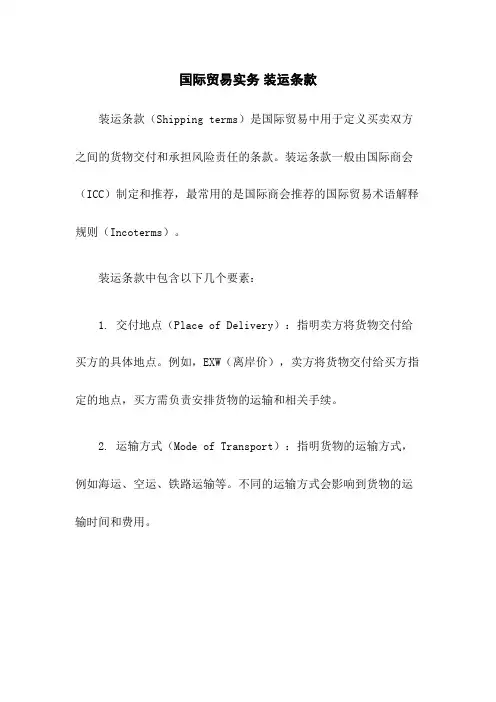
国际贸易实务装运条款
装运条款(Shipping terms)是国际贸易中用于定义买卖双方之间的货物交付和承担风险责任的条款。
装运条款一般由国际商会(ICC)制定和推荐,最常用的是国际商会推荐的国际贸易术语解释规则(Incoterms)。
装运条款中包含以下几个要素:
1. 交付地点(Place of Delivery):指明卖方将货物交付给买方的具体地点。
例如,EXW(离岸价),卖方将货物交付给买方指定的地点,买方需负责安排货物的运输和相关手续。
2. 运输方式(Mode of Transport):指明货物的运输方式,例如海运、空运、铁路运输等。
不同的运输方式会影响到货物的运输时间和费用。
3. 运输费用分担(Allocation of Transportation Costs):规定卖方和买方在货物运输过程中的费用分担方式。
常见的装运条款包括FOB(离岸运费支付)和CIF(到岸运费支付)等。
4. 交付时间(Delivery Time):确立买卖双方在货物交付方面的时间约定。
5. 运输保险(Insurance):规定货物在运输过程中的保险责任归属于卖方还是买方。
常见的保险条款有CIP(货物运输保险付费)和CPT(运输保险不付费)等。
6. 承担风险责任(Transfer of Risk):规定货物的所有权和风险在交货时由卖方转移到买方。
常见的装运条款有DDP(货物交货后责任转移)和DAT(到达目的地转移责任)等。
在国际贸易实务中,买卖双方根据具体情况选择适合的装运条款,以确保货物的安全交付和责任分担的清晰。
装运条款的选择对于国际贸易中的货物交付和风险管理非常重要。
国际贸易实务ppt课件(完整版)xx年xx月xx日目录•国际贸易概述•国际贸易政策与措施•国际贸易术语与惯例•国际货物买卖合同•国际货物运输与保险•国际货款结算与支付工具•进出口商品检验与监管制度•国际贸易争议解决机制01国际贸易概述特点受到多种因素影响,如政治、经济、文化等需要遵守国际贸易规则和惯例定义:国际贸易是指不同国家(和/或地区)之间的商品和劳务的交换活动。
涉及多个国家或地区通常涉及跨境交易和支付010203040506国际贸易定义与特点国际贸易发展历程以丝绸之路、海上丝绸之路为代表的古代贸易,促进了东西方文化和商品的交流。
欧洲中世纪城市的兴起促进了地区间贸易的发展,汉萨同盟等贸易组织出现。
工业革命的兴起推动了国际贸易的快速发展,自由贸易理论开始盛行。
全球化进程的加速使得国际贸易规模不断扩大,贸易自由化、便利化成为趋势。
古代贸易中世纪贸易近代贸易现代贸易国际贸易主体为不同国家的自然人或法人,国内贸易主体为本国自然人或法人。
交易主体不同交易标的不同交易规则不同影响因素不同国际贸易标的为跨越国境的商品和服务,国内贸易标的为本国境内的商品和服务。
国际贸易需遵守国际惯例、国际条约和各国法律法规,国内贸易主要遵守本国法律法规。
国际贸易受政治、经济、文化等多种因素影响,国内贸易主要受本国经济、政策等因素影响。
国际贸易与国内贸易比较02国际贸易政策与措施自由贸易政策的含义指国家对贸易活动不加以任何直接干涉,允许商品和劳务自由输出输入的政策。
自由贸易政策的理论基础亚当·斯密的绝对优势理论和大卫·李嘉图的比较优势理论。
自由贸易政策的主要措施取消一切限制贸易发展的障碍,促进贸易的自由发展。
保护贸易政策的主要措施:关税壁垒和非关税壁垒。
保护贸易政策的含义:指国家采取各种限制进口的措施,以保护本国商品在国内市场免受外国商品的竞争,并对本国出口商品给予优惠和补贴以鼓励其出口。
保护贸易政策的理论基础:重商主义和保护幼稚工业理论。